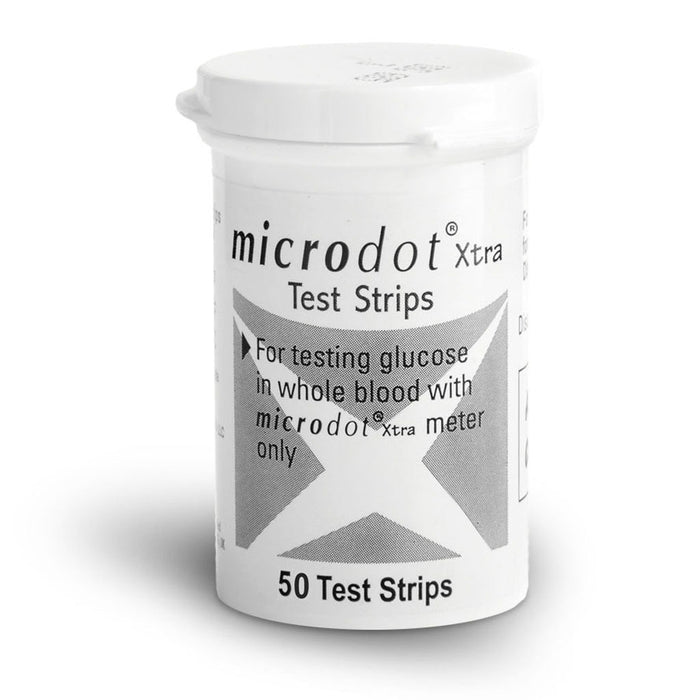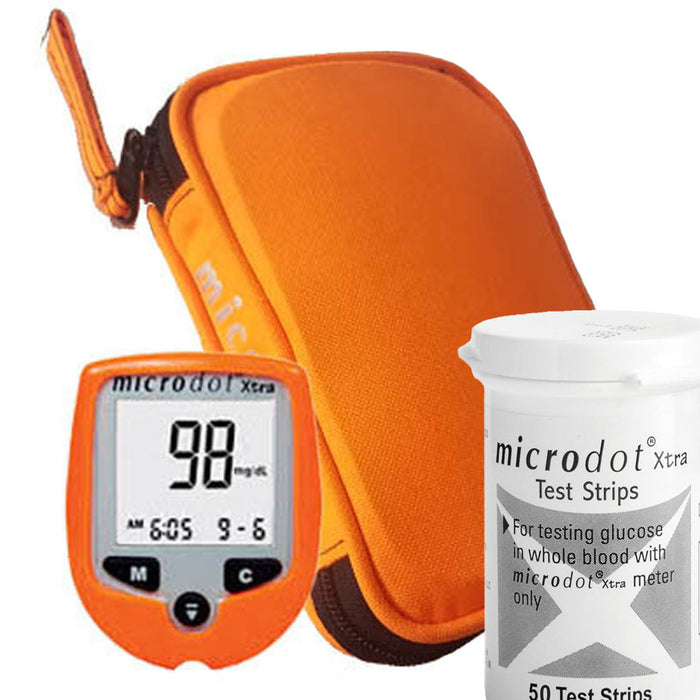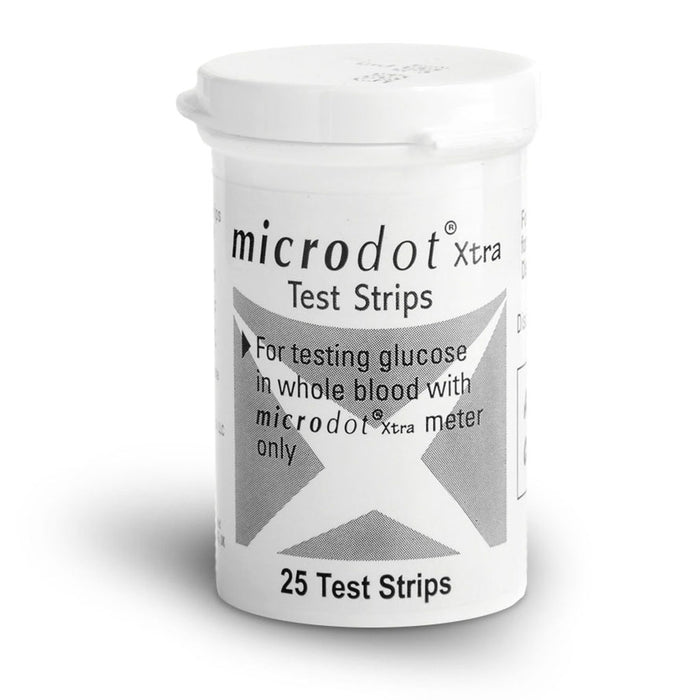



microdot® Xtra Test Strips measure glucose (sugar) in capillary whole blood outside of the body (in vitro diagnostic use) when used with the microdot Xtra Blood Glucose Test System. Strips are plasma calibrated to allow easy comparison of results with laboratory methods and feature a superior GDH-NAD chemistry, which cuts through 20+ substances known to commonly interfere with test results. The measurement range of the microdot® System is 20 to 525 mg/dL.
Performance of microdot® Test Strips has been evaluated both in laboratory and in clinical tests... Proven to consistently deliver reliable results when it matters most.
Accuracy:
The accuracy of the microdot® System was assessed by comparing blood glucose results obtained by 102 patients at one clinical center with those obtained using a YSI 2300 laboratory Instrument.Clark error grid analysis:
- 98% A region;
- 2 % B region
- Correlation coefficient R = 0.977.
- Range tested 45 to 472 mg/dL (2.5 to 26.2 mmol/L).
- Slope 0.973y-Intercept 3.96 mg/dL (0.22 mmol/L).
This means that the microdot® system compared well to a laboratory method.
Precision:
Within-Run Precision (20 replicates in 1 day)| Glucose: | VALUE(mg/dl) | CV% |
|---|---|---|
| Blood Avg: | 43 | 5.61 |
| Blood Avg: | 81 | 4.07 |
| Blood Avg: | 124 | 3.27 |
| Blood Avg: | 197 | 3.55 |
| Blood Avg: | 296 | 3.51 |
Total Precision:
| Glucose: | VALUE(mg/dl) | CV% |
|---|---|---|
| Low: | 45 | 5.42 |
| Mid: | 117 | 4.96 |
| High: | 371 | 4.89 |
| Blood Avg: | 197 | 3.55 |
| Blood Avg: | 296 | 3.51 |
*This means that the strip to strip variation was not greater than 5.6%.
Storage and Handling
- Store the strips in their original vial in a cool, dry place between 50° and 86° F (10°-30° C).
- Keep away from sunlight and heat.
- Do not refrigerate or freeze.
- When you take a strip from the vial, close the cap immediately. Use the strip immediately.
- Do not use microdot® Test Strips more than 90 days after the vial is first opened.
- Write the discard date on the vial when you first open it.
- Check the expiry date on the vial. If the expiry date has passed do not use the strips.
- Always code the meter for each new vial of strips according to the user manual.
Preparing to Test
- Take a strip from the vial and put it into the meter. Check that the black contact bars are facing the meter and the test zone and letters are facing up. Close the vial immediately.
- Push the strip in firmly until it stops. You will see the meter turn on automatically. The meter then checks each item of information on its display.
- You will then see the code number that the meter is using: "11" for example. Check that the code number on the screen and the code number printed on the vial are the same. If they are not the same, code the meter as instructed by the user manual.
- After the code number appears, the drop of blood symbol will appear and begin flashing. You can now apply the blood sample.
Getting a Blood Sample
- Take a strip from the vial and put it into the meter. Check that the black contact bars are facing the meter and the test zone and letters are facing up. Close the vial immediately.
- Wash your hands in warm, soapy water and dry well.
- Lance your skin with the microdot® lancing device.
- Squeeze gently until you get a rounded drop of blood. inconsistent with your symptoms. If the control result is within the acceptable range, check your test method and repeat your glucose test with a new strip. If the control result is not within the acceptable range, call microdot® Customer Service at 877-374-4062. Only use microdot® Control Solutions with microdot® Test Strips.
Testing
While the drop of blood symbol is flashing, touch and hold the top EDGE of the strip to the rounded drop of blood so it meets the test zone. The strip draws the blood into the test zone. Only apply blood while the drop of blood symbol is flashing. Do not use a smear or scrape blood into the strip. Hold the blood drop to the top EDGE of the test strip until blood has completely filled the test zone and the meter beeps. The meter will then count down in seconds 10,9,8….2,1 on the display. If the test zone does not fill up, stop the test and retest with a new strip. If you continue to have trouble, call microdot® Customer Service at 877-374-4062 for help.Your Result
- After 10 seconds the meter will beep, your glucose result will be displayed on the meter display and then automatically stored in the meter memory.
- Turn the meter off by removing the strip by hand or ejecting it as described below.
- To eject the strip, hold the meter vertically above a safe disposal bin with the strip pointing into the bin and push the eject button.
What Do Your Results Mean?
- Your blood glucose values will vary due to such things as diet, time of day and what you are doing. Your healthcare professional will help you to understand these variations.
- You should set your own range of expected blood glucose values, testing times, and discuss your blood glucose results with your healthcare professional.
Expected blood glucose levels for non-diabetic patients
Time Range,
Before Meals 70-105 mg/dL
1 hour after meal Less than 160 mg/dL
2 hours after meal Less than 120 mg/dL
Between 2 and 4pm Greater than 70 mg/dL
The normal fasting adult blood glucose range for a non diabetic is 70-105 mg/dL (3.9 - 5.8 mmoI/L).
Unexpected Results
Very high or very low blood glucose readings can indicate a serious medical condition. Repeat the test if you see an unusual reading. If these results are still unusual, or do not match your symptoms, contact your health care professional for advice. Hi or Lo readings may indicate hyper or hypoglycemia and should be treated immediately.
Checking Your System
A control solution is used to check the performance of the microdot® system and your test technique. Run a quality control check with microdot® Control Solution if your blood sugar result seems unusually high or low unlike your previous results, or is inconsistent with your symptoms. If the control result is within the acceptable range, check your test method and repeat your glucose test with a new strip. If the control result is not within the acceptable range, call microdot® Customer Service. Only use microdot® Control Solutions with microdot® Test Strips.
Some of the reasons for unusually high or Iow results:
- Poor technique.
- Strip was used after expiry date.
- Vial cap was not replaced and sealed.
- Storage in too high or too Iow temperatures.
- Wrong code number in meter.
- Strip was not used immediately after removing from vial. Whenever your blood glucose value is inconsistent with your previous results, glucose trends or your symptoms, contact your doctor. Follow the advice of your doctor before you change your therapy.
- Limitations.
microdot® Test Strips give accurate results when the following limitations are observed:
- Use fresh whole capillary blood. Do not use plasma or serum.
- Use each test strip once. Do not reuse.
- Do not bend cut or damage the test strip.
- Do not use for the testing of newborns.
- Not use during or after xylose absorption testing.
- Very high haematocrit levels (above 55%) may cause falsely Iow readings. Very Iow levels (below 25%) may produce falsely high readings. Consult your healthcare professional if you do not know your haematocrit level.
- Vitamin C (ascorbic acid) does not significantly affect results at normal levels or normal therapeutic levels. Abnormally high vitamin C levels may produce falsely high results.
- Cholesterol levels up to 500 mg/dL and triglycerides up to 3000 mg/dL do not affect results. The microdot® Test Strips should not be used with grossly lipemic samples with lipid levels beyond these levels.
- microdot® Test Strips may be used at altitudes up to 10,000 feet without an effect on test results.
- microdot® Test Strips are designed for use at temperatures between 50° and 104°F ( 10° C to 40°C) and relative humidity between 10% and 90%.
- Do not test critically ill patients with blood glucose meters. The readings may be misleadingly low if the patient is severely dehydrated, in shock, or in a hyperosmolar state (with or without Ketosis).
